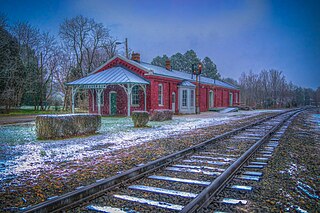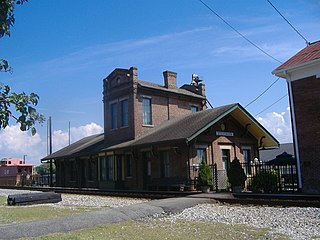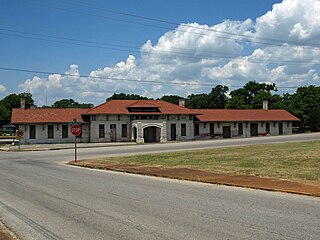
The Huntsville Depot located on the Norfolk Southern Railway line in downtown Huntsville is the oldest surviving railroad depot in Alabama and one of the oldest in the United States. Completed in 1860, the depot served as eastern division headquarters for the Memphis and Charleston Railroad. It is listed on both the Alabama Register of Landmarks and Heritage and National Register of Historic Places.

Upper Montclair is a New Jersey Transit station in Upper Montclair, New Jersey, a census-designated place of Montclair, New Jersey. The station is part of the Montclair-Boonton Line. The station is located between two grade level crossings on Bellevue Avenue and Lorraine Avenue, and between North Mountain Avenue and Upper Montclair Plaza parallel to the railroad, and is within steps of the Upper Montclair Business District. The station is 13.7 miles (22.0 km) on the Boonton Line. Closing the grade crossing of Lorraine Avenue is being considered for safety reasons.

Grand Canyon Depot, also known as Grand Canyon Railroad Station, was constructed in 1909–10 for the Atchison, Topeka and Santa Fe Railway at the South Rim of the Grand Canyon, in what is now Grand Canyon National Park. It is one of three remaining railroad depots in the United States built with logs as the primary structural material. The station is within 330 feet (100 m) of the rim of the canyon, opposite the El Tovar Hotel, also built by the railroad. The depot is designated a National Historic Landmark, is listed the National Register of Historic Places, and is included in the Grand Canyon Village National Historic Landmark District.

The William Aiken House and Associated Railroad Structures make up a National Historic Landmark District in Charleston, South Carolina, that contains structures of South Carolina Canal and Railroad Company and the home of the company's founder, William Aiken. These structures make up one of the largest collection of surviving pre-Civil War railroad depot facilities in the United States. The district was declared a National Historic Landmark in 1963.

Beaverdam Depot is a historic railway depot located at Beaverdam, Hanover County, Virginia.

Greenlawn is a historic residence between Meridianville and Huntsville, Alabama. The house was built in 1849–50 by William Otey, replacing a log house built by his father in the early 1810s. Following William and his wife's deaths, the house was taken over by one of their granddaughters in 1907. Around 1925, the original Italianate portico was replaced with the current Greek Revival entrance, and a northern wing was added. The house fell vacant in 1963 and was later restored, now sitting at the entrance to a subdivision of the same name.

The Stevenson Railroad Depot and Hotel station are a historic train station and hotel in Stevenson, Alabama. They were built circa 1872 as a joint project of the Memphis and Charleston Railroad and the Nashville and Chattanooga Railroad, whose lines converged in Stevenson. When the Memphis & Charleston was purchased by the Southern Railway in 1898, the Louisville and Nashville Railroad took sole control of the depot and operated it until 1976. It was converted into a history museum in 1982. Both buildings are brick with gable roofs and Italianate details. The depot has a central, second-story tower that was added in 1887. The three-story hotel had a lobby, dining room, and kitchen on the first floor and eight large guest rooms on the upper floors. The buildings were listed on the Alabama Register of Landmarks and Heritage in 1975 and the National Register of Historic Places in 1976.

The Southern Railway Depot is a historic building in Decatur, Alabama. The depot was built in 1904–05 along the Southern Railway line. Decatur had become a transportation hub of North Alabama by the 1870s, with its connections to the Tennessee River, the east–west Tuscumbia, Courtland and Decatur Railroad, and the north–south Louisville and Nashville Railroad.

Preuit Oaks is a historic plantation house near Leighton in Colbert County, Alabama. The house was built in 1847 by Dr. John S. Napier, on land originally owned by his father-in-law. The house and land were sold in 1851 to W. Richard Preuit, who developed the property into a large cotton plantation using the forced labour of enslaved people. At its peak in 1860, the plantation covered 1,500 acres ; following the Civil War, its productivity declined, and Preuit's holdings had depleted to only 400 acres upon his death in 1882. The house has remained in the family since.

The John Daniel Rather House is a historic residence in Tuscumbia, Alabama. The house was built in 1823 by William H. and Catherine Winter, who came to The Shoals from Prince William County, Virginia. It was taken over by the Union Army during the Civil War and used as the headquarters of General Florence M. Cornyn. After the war, the house was purchased by John Taylor Rather, an early North Alabama settler who was deputy sheriff of Madison County, and a longtime member of the Alabama House of Representatives and later the Alabama Senate. His son, John Daniel Rather, also served in both houses of the state legislature, and was President of the Memphis and Charleston Railroad.

The Ernest Edward Greene House is a historic residence in Cullman, Alabama. The house was built in 1913 by Ernest Edward Greene, the superintendent of Southern Cotton Oil Company. After Greene's death in 1922, the house was passed on to several more owners, including John George Luyben, Sr., who lived in the house for 34 years.

The Louisville and Nashville Railroad Depot is a historic train station in Cullman, Alabama. The depot was built in 1913 as a replacement for Cullman's original station. Cullman's founder, John G. Cullmann, gave money to the city upon his death in 1895 to lower the Louisville and Nashville Railroad tracks through town, in order to reduce noise and pollution. The plan was not enacted until 1911, when the L&N laid double tracks through the town, necessitating the construction of a new depot. The depot served passengers until 1968, and was used for maintenance storage by new owners CSX until it was sold to the city in 1990. It was restored and now houses offices for the local United Way chapter.

Stiefelmeyer's is a historic commercial building in Cullman, Alabama. The store was founded in 1888, and occupied a two-story frame storehouse until it was destroyed by fire in 1892. Although brick had already become the material of choice for commercial buildings in the town, the current Stiefelmeyer's was built in 1892 of wood. An addition was constructed in 1900, expanding the building to its current size. As other wood commercial buildings were destroyed by fire and replaced with brick structures, Stiefelmeyer's remains the only example of the once-dominant building material in Cullman's commercial district.

The Wadley Railroad Depot is a historic train station in Wadley, Alabama. The depot was built in 1907 along with the Atlanta, Birmingham, and Atlantic Railroad line as part of an expansion from West Point, Georgia, to Talladega, Alabama. The Callaway Corporation, who operated numerous textile mills along the Chattahoochee River and later founded Callaway Gardens, purchased the land that would later become the town of Wadley, intending to build a mill in the town. The deal fell through before the mill was built, but the town continued as a local agricultural trading hub. The station closed to passenger traffic in 1964, and the line eventually came under the control of CSX Transportation.
The Seaboard Coast Line Railroad Depot was a train station in Headland, Alabama. The depot was built in 1893 by the Abbeville Southern Railway, which built a line to connect Abbeville with the Alabama Midland Railway at Grimes. The Alabama Midland and Abbeville Southern became part of the Plant System in 1894, which was taken over by the Atlantic Coast Line Railroad in 1901 and merged into the Seaboard Coast Line Railroad in 1967. Regular passenger service through Headland ended in 1929, although mixed service on freight trains continued through the mid-1950s. Freight service was discontinued in 1979. Despite efforts to renovate and repurpose the building, it was demolished after 1980.

The Dothan station, also known as Atlantic Coastline Railroad Passenger Depot, is a historic train station in Dothan, Alabama. It was built in 1907 as the largest and busiest on the Atlantic Coast Line Railroad between Montgomery, Alabama, and Thomasville, Georgia and replaced a former freight depot. The Atlantic Coast Line merged with the Seaboard Air Line Railroad in 1967 to form the Seaboard Coast Line Railroad. In 1971, Amtrak took over passenger rail service in the United States and Dothan station was served by the Floridian until 1979.

The Pierceton Historic District encompasses the central business district of a small community in east central Kosciusko County, Indiana. It is next to the former Pennsylvania Railroad line. The design, setting, materials, workmanship and association between buildings give a sense of the history and architecture of a small town main street.

The A. J. and Emma E. Thomas Coley House is a historic residence in Alexander City, Alabama. The house was built by A. J. Coley, a physician who was born near Alex City in 1858. After studying medicine in Philadelphia and New York City, Coley returned to Alabama and married Emma E. Thomas. In 1895, the couple built their house in Queen Anne style, a popular style for houses in the late 19th century. Coley served as mayor of Alex City from 1902 to 1903. In 1909 Coley sold the house to another physician, James Adrian Googan, who used it as his residence and an infirmary. Except during World War II, when it was subdivided into apartments, it has been maintained as a single-family home since Googan's death in 1920.

Harbor Springs is a depot located at 111 West Bay Street in Harbor Springs, Michigan. It was listed on the National Register of Historic Places in 2000 as the Grand Rapids and Indiana Railroad Harbor Springs Depot. As of 2016, the building houses the Depot Club and Restaurant.

The Twin City Historic District in Twin City in Emanuel County, Georgia is a historic district which was listed on the National Register of Historic Places in 2014.























